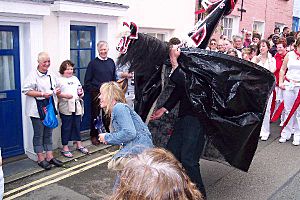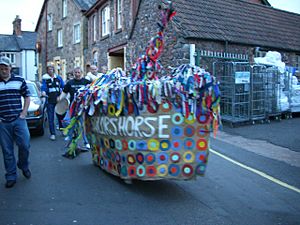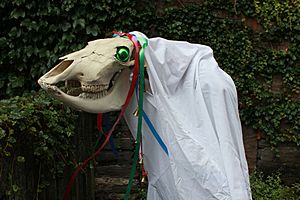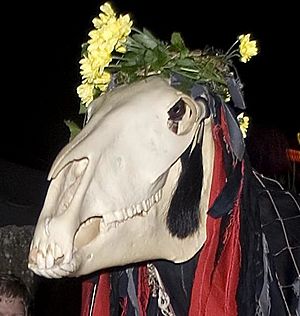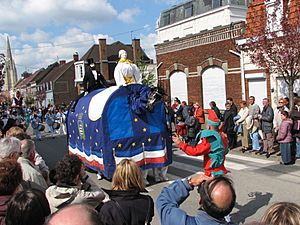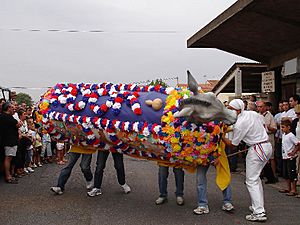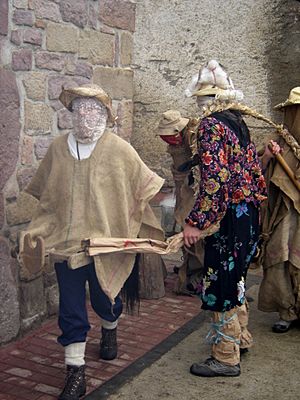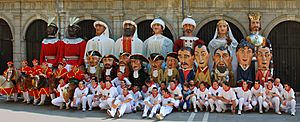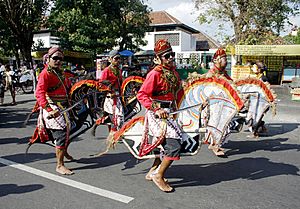Hobby horse facts for kids
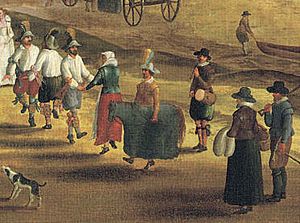
In old stories and traditions, a hobby horse is a person dressed up as a horse. These characters appear in many traditional celebrations, parades, and special events around the world. They are especially famous in England during May Day parties, mummers' plays (old plays performed by traveling actors), and the Morris dance.
Contents
- What is a Hobby Horse?
- Different Kinds of Hobby Horses
- Hobby Horse Traditions
- Other Meanings of "Hobby Horse"
- See also
What is a Hobby Horse?
The word hobby used to mean a small or medium-sized horse, like a pony. The term "hobby horse" then came to mean a pretend horse used in performances. It's like how the name "Dobbin" became a common name for a cart-horse.
Different Kinds of Hobby Horses
Hobby horses can be built in many ways. In the United Kingdom, they are often grouped into these types:
- Tourney horses look like a person riding a small horse wearing a long cloth coat. A round or oval frame hangs around the performer's waist or chest, with a skirt covering it down to the ground. The frame has a carved wooden head, often with jaws that can snap shut when a string is pulled. A tail is at the other end. The "rider" might wear a cape to help hide the frame.
- Sieve horses are a simpler type, found only in Lincolnshire. They are made from a farm sieve frame, with a head and tail attached. This frame hangs from the performer's shoulders. The performer wears a horse blanket that covers them and the sieve.
- Mast horses are meant to look like the horse itself. They have a head made of wood, or sometimes a real horse's skull. This head usually has hinged jaws that can snap. The head is attached to a stick about 1 meter (3 feet) long. The person playing the horse bends forward or crouches, holding the head in front of them and resting the stick on the ground. A tail might be attached to the back of the cloth that covers the performer.
Not all hobby horses fit these types. For example, the famous May Day horses at Padstow and Minehead are large structures. They are carried at shoulder height, with only the performer's head showing. The performers wear tall, pointed hats and masks. The Padstow horses have round frames with small, snapping heads on long necks. The Minehead horses are more boat-shaped and have no heads, but they have long, trailing tails.
In other countries like France and Belgium, large hobby horses are carried by many people. In Indonesia, flat horse shapes are held between dancers' legs.
Hobby Horse Traditions
British Traditions
May Day Hobby Horses
Padstow 'Obby 'Oss
The most famous British hobby horses are probably from the May Day 'Obby 'Oss festival in Padstow, Cornwall. These horses are made from a round frame covered with shiny black material. A dancer carries it on their shoulders, with their face hidden by a mask attached to a tall, pointed hat. A skirt hangs down from the frame. There's a small wooden horse's head with snapping jaws on a long neck, and a horsehair tail at the back.
Padstow has two rival horses: the Old 'Oss (decorated with white and red) and the Blue Ribbon 'Oss (or "Peace 'Oss," decorated with white and blue). Each 'Oss has its own loyal group of supporters. A "Teaser" dances in front of each 'Oss, waving a padded club. They dance through the streets with lively music from melodeons, accordions, and drums, playing Padstow's traditional May Song. Sometimes, the 'Osses playfully "capture" young women under their skirts.
Children often make their own "Colt" 'Osses and have their own May Day parades.
Minehead Hobby Horse
At Minehead in Somerset, there are three rival hobby horses: the Original Sailor's Horse, the Traditional Sailor's Horse, and the Town Horse. They appear on May Eve, May Day morning, and the following two days. Each horse is a boat-shaped wooden frame, carried on the dancer's shoulders. The dancer's face is hidden by a mask and a tall, pointed hat. The horse is covered with ribbons and fabric strips. A long fabric skirt, painted with colorful circles, hangs to the ground. A long tail is attached to the back. Each horse has a small group of musicians and helpers. These horse visits are believed to bring good luck.
Hunting the Earl of Rone
At Combe Martin in Devon, a custom called "The Hunting of the Earl of Rone" happens over four days during the Spring Bank Holiday. A fool and a hobby horse, along with soldiers, search the village for the Earl. He is eventually caught, put on a real donkey, and paraded through the village. The soldiers often pretend to shoot him, and he falls off. The hobby horse and the fool then "revive" him. Finally, on the beach, the Earl is "executed" and thrown into the sea.
Morris Dance and Other Rituals
-
Some modern dance groups have creative hobby horses, like this zebra.
A hobby horse is shown in an old stained glass window from 1550-1621, now in the Victoria and Albert Museum in London. It's placed below a Maypole and surrounded by what look like morris dancers. An old painting from around 1620 also shows Morris dancers with a hobby horse by the River Thames.
Some historical English Morris dance groups had hobby horses. Today, many modern Morris dance teams also include them. For example, the Pig Dyke Molly molly dancers, who wear black and white costumes, have a hobby zebra!
A hobby horse also takes part in the very old Abbots Bromley Horn Dance. The original horse has been replaced by a more realistic carved one in recent years.
Other British Customs
Hodening or Hoodening
This custom took place around Christmas in eastern Kent. A group of farmworkers would lead a Hooden Horse. This was a wooden horse's head on a short pole, with snapping jaws. A person hidden under a sack or blanket would operate it to make the horse's body. This custom has been brought back to life in many places.
Laare Vane
This is a New Year custom from the Isle of Man. It involves a white-painted wooden horse's head with red snapping jaws and a white sheet attached. A man would carry the head, rushing into a room and chasing any girls out of the house. If the Laare Vane (white mare) caught a girl, she would take his place under the sheet. A sword-dance was then performed with sticks by six male dancers.
Mari Lwyd
The Mari Lwyd ("Grey Mare" in English) is a similar creature from Wales, made from a horse's skull with a white sheet. It was part of New Year house-visiting traditions to bring good luck. The Mari Lwyd group would try to enter a house by singing verses back and forth with the people inside. If the householders couldn't come up with a final verse, the Mari was allowed in. This custom has also been revived recently.
Old Horse or 'Owd 'Oss
In parts of England like Nottinghamshire and Derbyshire, a Christmas and New Year custom involved going from house to house performing a short play or song called The Old Horse. The Old Horse was a "mast" type, similar to the Wild Horse of the Soul-cakers. This tradition still continues at Richmond, Yorkshire, at Christmas. Three men lead a horse made from a stuffed horse's head on a pole, with a man hidden under a blanket. They sing the Poor Old Horse song, and the horse snaps its jaws. The custom includes the horse's "death and resurrection."
Penglas or Penglaz
This creature from Cornwall means "grey head." It was a "hooden" or "mast" type of horse, carved from wood or made from a horse's skull, like the Welsh Mari Lwyd. It went with Christmas performers called Guisers. Its body was a horse's hide or cloth. This animal has been brought back in Penzance recently as Penglaz the Penzance 'Obby 'Oss. It now appears during a modern Midsummer festival instead of around midwinter.
Plough Monday Mummers
In parts of England like Lincolnshire and Nottinghamshire, mummers' plays were performed around Plough Monday in early January. These groups, called Plough Stots or Plough Jacks, would parade through villages. Old photographs show teams with two hobby horses of the "sieve" type. The "rider" was disguised by wearing a horse-cloth that covered their head and body, making it look like a horse riding a horse!
Salisbury Giant and Hob-Nob
The Salisbury Giant is a huge 12-foot-tall figure, unique in Britain. It rarely appears now and is kept in the Salisbury and South Wiltshire Museum. With it is its companion, Hob-Nob, a tourney-type hobby horse. Hob-Nob was a mischievous character who used to clear the way for the Giant in parades held by the Tailor's Guild on Midsummer's Eve. Hob-Nob's rider's face and body were hidden by a thick veil.
Soul-caking or Souling
Some versions of the mummers play, performed around All Souls' Day in Cheshire, included a silent character called the "Wild Horse." This horse was made from a horse's skull on a short pole. The man playing the horse was hidden under a cloth and could snap the horse's jaws loudly to scare people.
Winster Hobby Horses
A unique custom with three hobby horses is known only from a photograph taken at Winster Hall, Derbyshire, around 1870. Eight or nine performers are shown, most with their faces hidden. They are grouped around a mast horse with a shiny black head. Two other men wear military-looking jackets and ride small hobby horses of a unique design. These horses have a cylindrical body held between the rider's legs, with a flat, curved wooden neck and a small, stylized head with snapping jaws. The horsemen are masked in light-colored cloth.
European Traditions
Austria
Sankt Lorenzen im Lesachtal, Carinthia
The Fasnacht (carnival) parade in Sankt Lorenzen im Lesachtal, Austria, features a large, lively hobby horse. It has a hollow body, covered by a long white sheet, with a long neck and head made of cardboard. Two people hidden under the sheet carry it. The horse has colorful ribbons and is led by a man in a red jacket. A boy sometimes pokes it with a hay-fork, and a blacksmith carries a hammer. Sometimes the horse falls down and is "shod" (the blacksmith hammers the shoe soles of the carriers). It then revives and continues through the village.
Belgium
Lumeçon, Ducasse de Mons
Also known as the "Doudou," the Ducasse de Mons is a festival in Mons that takes place on Trinity Sunday. One part, called the Lumeçon, shows the fight between St George and the Dragon. A large dragon with a very long tail is featured. St. George tries to kill the dragon with his lance, but fails, so he uses a pistol. Old drawings show the dragon with three "tourney" type hobby horses. Today, these animals are made of cow-hide and look more like dogs. They are called Chinchins and help St. George. This festival has been recognized by UNESCO as an important cultural heritage.
Czech Republic
Killing the Mare, Shrovetide
The Shrovetide parades in Hlinsko, Czech Republic, end with a ritual called "Killing the Mare." Men and boys in colorful costumes visit every house, accompanied by a brass band. There are usually two or three "tourney" type hobby horses. Other characters include the Straw Men, who are dressed in straw and have blackened faces. They hug women and roll on the ground, which is said to bring good luck and fertility.
Four dancers, representing Turks, perform a dance in front of each house to ensure wealth and a good harvest. They must lift their legs high to ensure tall crops. At the end of the day, one of the hobby horses is "killed" for its supposed sins. It is then "brought back to life," and a dance begins with everyone joining in. This custom has survived even after being banned in the past and is now recognized by UNESCO.
France
Le Poulain de Pézenas
At Pézenas, there is a huge creature called Le Poulain or Lo Polin (meaning "the colt"). Nine men carry it, and another leads it, with a band of musicians. The Poulain has a realistic carved wooden head with snapping jaws and a neck that can stretch up to first-floor windows. Money put into its mouth falls inside its neck. Its body is covered with dark blue cloth, decorated with stars and the coat of arms of Pézenas.
The Poulain carries two figures on its back, a male and a female, called Estieinou and Estieinette. The Poulain is said to remember a visit by King Louis VIII in 1226. His favorite mare fell ill and had to be left behind. When he returned, he was amazed to find she had recovered and given birth to a fine colt. The king then ordered the town to build a wooden colt for all its public celebrations. The Poulain was burned during the French Revolution but was brought back in 1803.
There have been smaller, junior Poulains made for children in Pézenas. Similar creatures exist in other towns like Saint-Thibéry, Adissan, and Florensac.
Lou chivalet or le chevalet
"Tourney" type hobby horses, with a frame around the dancer's waist, also appear at festivals in the Languedoc region of France. An old drawing and photograph of the chivalet dance are shown in the folk museum at Agde. It is especially linked to Florensac, where it is called le chevalet and is the town's special animal.
L'âne de Bessan
The Donkey or Ass of Bessan is another "totem" animal from Languedoc. It's smaller than the Poulain and made from a frame covered in cloth, decorated with paper flowers. Four men carry it under its skirt, led by another man in white who cracks a whip. The Âne dances from side to side to traditional tunes. Sometimes the donkey bucks its back legs into the air. The Âne is brought out to open the feast of St Laurent.
Poland
Lajkonik
The city of Kraków has a hobby horse called the Lajkonik. It traditionally appears on the first Thursday after the religious feast of Corpus Christi. It parades through the streets, collecting money, with musicians and costumed followers. The Lajkonik's colorful costume looks like a bearded Tatar warrior, riding a white horse. People believe that being touched by its golden mace brings good luck. This custom is said to be 700 years old, and many stories explain its origins. The hobby horse has become an unofficial symbol of Kraków.
Spain
Basque Areas
The Basque country has a strong dance tradition. The zamaltzain, a "tourney" type hobby horse with a small wooden head and a lacy skirt, takes part in dances and parades. The "rider" wears a fancy red or black costume, including a tall, ribboned hat with a mirror. Zamaltzain means mule-keeper. The dance is performed by two teams, one in red and one in black.
A more rustic-looking horse, called the zaldiko, is part of the Carnival celebrations at Lantz. It is an important part of the carnival parade, along with the ziripot, a strange character in a huge straw-stuffed costume.
Parade of Giants and Big-heads, Pamplona
Six "tourney" horses (xaldiko or zaldiko), dressed in red with yellow trim, take part in the comparsa de gigantes y cabezudos in Pamplona. They look more realistic than other Basque examples, showing the whole upper part of a horse's body with a skirt below. Each "rider" wears a pointed cap and used to carry an inflated bladder on a stick. Now, they carry a foam-rubber whip to playfully hit onlookers.
Catalonia
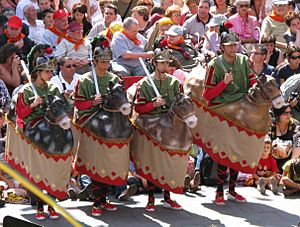
Many festivals in the Catalonia region of Spain have parades with giant figures and large animals. Some also include hobby horses of the "tourney" type, often made from fiberglass today.
Larger figures of mules are also found, carried by two performers whose legs are seen below the animal's hollow body. dragons, bulls, eagles, and lions are also popular. Many have fireworks attached to them, making for a spectacular sight.
Festes de Santa Tecla, Tarragona
The Santa Tecla Festival in Tarragona includes parades with many animals, both real and mythical. One of them is a larger-than-life Mulassa (mule), carried by two dancers hidden under its skirts. Other creatures in the parade include the àliga (eagle), bou (bull), cucafera (a mythical monster), drac de Sant Roc (dragon), lleó (lion), and víbria (a female dragon). Many of these have fireworks, creating amazing displays.
Asian Traditions
Indonesia
Kuda Kepang, Kuda Lumping or Jaran Kepang
Kuda Lumping (meaning "woven bamboo horses") is a traditional Javanese dance from the island of Java, Indonesia. It shows a group of horsemen. Dancers "ride" horses made from woven bamboo, decorated with colorful paints and cloth. The dance usually shows troops riding horses, but some Kuda Lumping performances also include trances and magic tricks.
This art form has been brought to nearby Johore and Singapore by Javanese migrants. It is performed at weddings by special dance groups. Modern performances often tell stories of the legendary nine Muslim saints who brought Islam to Java. They are often short and meant for entertainment, and sometimes even women perform them.
North American Traditions
Newfoundland Mummering
In Newfoundland, "mast" type hobby horses were sometimes used by the mummers or 'janneys' who went mummering around Christmas. They also sometimes took a Christmas bull, made in a similar way, on their house-to-house visits. The playful horse was not meant to be scary, but its appearance often surprised people. Mummering was fading away but has recently become popular again.
Other Meanings of "Hobby Horse"
The term "hobby horse" also led to the saying "to ride one's hobby-horse," which means to follow a favorite pastime. This is where the modern word hobby comes from!
The term is also connected to the draisine, an early version of the bicycle. In 1818, a London coach-maker made an improved version, which was popularly called the "hobby-horse."
The art movement, Dada, might even be named after a French child's word for hobby horse.
In sailing, if a ship is rocking back and forth in the sea, it is said to be "hobby horsing."
See also
- Hobby horse (toy)
- Hooden horse
- Dada - An art movement possibly named after the French word for hobby horse
- Pantomime horse


